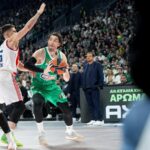
At the end of the day, the NBA Europe project is focused on generating revenue. Part 4 of our series on FIBA and the NBA’s new basketball league focuses on the broadcast and media strategy — arguably the single most important financial pillar for NBA Europe. We break down the potential for success, the very real risks, and how the continent’s fractured media landscape could complicate everything.
Read Part 1: The High Price of NBA Europe.
Read Part 2: Can NBA Europe Take Over?
Read Part 3: Will Europe’s Top Clubs Join NBA Europe?
No matter how strong the branding or the basketball, NBA Europe will live and die by how well it performs on screen. The league’s financial future hinges on selling a media product that works across a fragmented continent. That may prove far harder than the NBA expects.
The Broadcast Gamble
A core strength the NBA brings to the table is undoubtedly the polish in its broadcast product. This goes across everything from production to access through storytelling. There is a standard of production expected by all viewers when they turn on a NBA game that is different to even the highest other levels of basketball.
Euroleague’s broadcast footprint, in terms of where it can reach, isn’t all that dissimilar to the NBA’s. The difference, of course, is in what it gets back in return. There’s no single source for Euroleague’s total broadcast rights but the napkin maths has them at only €40 million or so. That’s less than 1 per cent of the close to $7 billion the NBA rakes in annually through media revenue.
FIBA and the NBA want to develop a centralised, premium product with NBA Europe. That sounds great as an idea but Europe’s media and media rights landscape is regionally fragmented. Broadcasters across these regions have an idea of what € price they put on top tier European basketball. Even with the NBA badge on it, they may not see the value anywhere close to what the league believes it can get.
One League, Many Tongues
The NBA has a lot of advantages going for it. Few are as overlooked as the English language. The US market is varied but it has one common language. That’s an enormous edge that regularly gets taken for granted when international expansion is considered.
With Europe, it’s pretty much a separate language in each country, more in some cases, and the local media ecosystems are designed with that in mind. Spreading cohesive league wide narratives is difficult when you essentially have to default to English for such stories.
Success for NBA Europe requires more than multilingual commentary. To reach the necessary standard, the whole production must be developed with each region’s needs in mind. That’s an element UEFA has gone to great lengths to ensure with its products. It is possible to balance brand consistency with local needs but it requires time, people, and money to do it.
It’s an issue that FIBA and Euroleague have been forced to tackle over the decades. Native English speaking markets in Europe tend not to be big basketball markets. While in the rest, it’s the language of international business perhaps but not the one for entertainment. Heavy localisation, and investment therein, is vital for the project to succeed.
BallinEurope is ramping up its YouTube game this season. Subscribe to our channel now for player exclusives, analysis videos, and much more.
Who Will Pay?
The new NBA media rights contract is enormous. That didn’t really surprise anyone as, while there will be a ceiling, the media rights market is still on an upward trajectory. Where the NBA struggles to maximise revenue is in rights money outside of the US and Canada.
The aforementioned gap between Euroleague’s media rights haul and the NBA’s is going to matter when it comes to NBA Europe. Football is king in Europe and will be for decades to come. In the US, the NBA is familiar with this issue but still does well on the second tier of rights.
Basketball on this side of the Atlantic, when it comes to market value, is a bigger step down. Indeed, it’s downright niche by comparison. The NBA and FIBA essentially want buyers to believe they are getting a top-tier product and not some repackaged licensed imitation. Couple the obvious doubts that come with that with the market fragmentation and that’s an enormous challenge to overcome.
BallinEurope has a book, a real life actual book called I Like it Loud, and you can buy it on Amazon now. It’s here as a book and here in Kindle form.
Digital vs Linear
Day 4 of our series closes with a double edged sword. The NBA is a global leader when it comes to maximising digital media. Only Major League Baseball can compare when it comes to maximising usage.
That is great for engaging a global market. It also ensures this market is familiar with NBA basketball and expects that to be the basketball they interact with. Converting European viewers of the NBA to a localised product may not be easy when they can easily watch Nikola Jokic or Giannis Antetokounmpo on their smartphones already.
Neither Euroleague nor FIBA can claim to remotely match the NBA’s digital game. How could they? The resources simply aren’t there to do so. The NBA however has a chance to make League Pass the true Netflix of basketball with NBA Europe. This would require the approach being digital first, partnered with local media operators, and targeted at younger fans. If they do that, they have a chance. Still, it’s a tough road ahead given the assorted challenges with the media buyers. That is before we get to the segment that is often left to the end of such discussions, the fans. They will be the focus of tomorrow’s conclusion to the series.
The NBA and FIBA plan on launching a European league in 2026 — but can it really work? In this five-part series, we dive into the financial gamble, the structural chaos, the club politics, the media game, and the cultural fight for basketball’s soul. From billion-dollar ambitions to legal landmines and fan resistance, NBA Europe: The Grand Experiment breaks down the biggest shake-up in European hoops in decades.




Leave a Reply